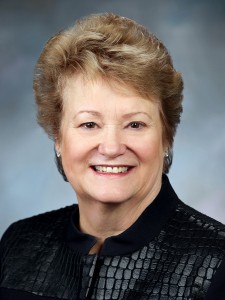19 Jun On The Same Page?
 Until now, the City of Seattle freight plan was a little like the homework the dog ate. The city meant to do a freight plan. It just never finished one.
Until now, the City of Seattle freight plan was a little like the homework the dog ate. The city meant to do a freight plan. It just never finished one.
Mayor Ed Murray now pledges to complete the freight plan and state Rep. Judy Clibborn believes he will, a view she will share at the June 24 meeting of the Manufacturing Industrial Council.
Her optimism is significant because Clibborn is chair of the House Transportation Committee of the Washington State Legislature. State and city cooperation is required to fix some of the major problems that bog down SODO. Read more about those challenges here.
Clibborn feels Murray “gets it” when it comes to freight because of the 18 years he spent as a member of the State Legislature viewing transportation from a state perspective. State government experience is rare among city leaders. In fact, Murray is the first person since Wes Uhlman to become mayor after serving in Olympia. Uhlman made the leap 46 very long years ago.
Says Clibborn:
“If you become Seattle mayor after experience in local government, you might view the port as the Port of Seattle or the Port for Seattle. If you become the mayor after experience in state government, you might tend to view it as a port for Seattle and the State of Washington. I think Mayor Murray sees the bigger picture.”
The Emerald City is a major crossroads for much of the commerce that rolls, floats and flies through the state. The large volumes that move through north SODO are also mixed with two major league sports stadiums that attract millions of motorists and pedestrians every year who mix with mainline heavy-gauge railroad tracks carrying dozens of freight and passenger trains every day.
But, while the city’s freight issues are large and complex, until Murray took office, a plan for freight never made it off the City Hall “to do” list.
The notion of a freight plan was discussed but died during the tenure of Mayor Greg Nickels. The City Council required completion of a freight access plan for SODO as part of the 2012 agreement to guide environmental review of the SODO NBA arena proposal. That put the job in the lap of previous Mayor Mike McGinn. McGinn never got around to it.
The failure to do the freight plan frustrates some because city government has been so enthusiastic about planning for other travel modes. In the years a freight plan was discussed, the city started and completed two comprehensive strategic plans for bicycles along with plans for transit service and pedestrian safety. Worthy causes all, but the visibility of those efforts contrasted with the lack of focus on freight.
In his race last fall with McGinn, Murray cited the lack of a freight plan as an example of city government losing touch with the basics that drive the industrial job base. At an “industrial summit” on May 19, Murray reaffirmed his commitment to complete the freight plan and a staff team is now being assembled to conduct one. He also announced the city will pursue a heavy haul corridor plan to support marine cargo truck traffic.
Like Clibborn, many welcome that news, but freight planning for SODO is more complicated than it might sound. Federal agencies govern heavy railroad operations. Sound Transit and Metro independently operate light rail and bus services while also running major SODO maintenance facilities. The Port owns the public marine cargo terminals operated by private companies. US agencies control maritime shipping and air travel. Roadways are a mixed bag of local, state and federal responsibilities.
And the two professional sports stadiums in north SODO operate according to nationally scheduled game times set by collective bargaining agreements with players, team travel times and media broadcast schedules. When those outside factors require weekday baseball games or weeknight football games, SODO’s gridlock possibilities grow significantly.
Another major twist is continued access along the central waterfront for trucks moving between Ballard and south Seattle.
The complexity and scale of Seattle freight makes it important that the city and state work together and new opportunities are available that require them to do so.
Washington State Department of Transportation (WSDOT) is now finishing a statewide freight plan that takes in Seattle. Public comment on that plan ends in August, just as the city plan will be getting underway.
Under new federal funding requirements, local transportation projects must be included in state transportation plans to qualify for federal construction aid. That requirement raises the stakes on city-state cooperation if federal assistance will be sought to help pay for a badly needed, but highly expensive overpass to separate railroad trains from street traffic in SODO.
Hear more about these issues and others at the MIC meeting next Tuesday at the Georgetown Campus of South Seattle Community College. The meeting will be held in room C-122 in the Gene J. Colin Educational Hall at the southwest corner of the campus. Enter the parking lot at 6737 Corson Avenue. RSVP to Christine Jones at christine@box2063.temp.domains.
Clibborn will be joined at the meeting by Rep. Gael Tarleton from the 36th Legislative District in north Seattle. A former Seattle Port Commissioner, Tarleton is the primary sponsor of a new state effort that in 2015 will assess the needs of maritime, manufacturing and other industrial sectors throughout the state (including Seattle). Tarleton’s effort will recommend state actions to address education, regulatory and infrastructure issues.
Seattle City Councilmember Nick Licata will also address the meeting. Licata is a champion for the new minimum wage and other social justice issues. He is also a long time advocate for the city’s industrial job base. Agree or disagree with him, Licata is always willing to explain and exchange viewpoints.
The elected officials will be joined by Eugene Wasserman, head of the North Seattle Industrial Association and a key player in the successful campaign last year to create a district basis for electing Seattle City Councilmembers. Councilmembers are presently voted on by voters citywide. Starting in 2015, seven of the nine councilmembers will be elected from specific geographic districts within the city. Wasserman will provide his views about changes that could occur with the new district election system.
Metaphorical dogs might still eat civic homework from time to time, but under the new district system, at least you’ll know where the critters come from.
